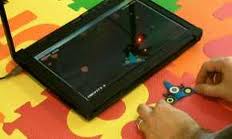“Portico” A Touch Tablet without Touch-Screen
 Researchers at the University of Washington have developed a new tablet that can recognize gestures and objects that are outside the screen area.
Researchers at the University of Washington have developed a new tablet that can recognize gestures and objects that are outside the screen area.
A team of scientists from the University of Washington (UW) in Seattle is currently working with engineers from Intel and Microsoft on a novel gesture control system for tablet computers, which goes well beyond what is currently possible with normal touch screen. The project, called Portico lead to devices that can be operated much simpler than current mobile devices, because they have more space than the regular screen.
“The idea is to create an interactive area that goes beyond the screen,” explains Jacob Wobbrock , computer scientists at the UW, who was involved in the project. This is achieved by folding two cameras that sit on either side of the screen and moves around the screen can detect. The system can be determined by the constant comparison of camera images and the height of objects and determine whether they affect the surrounding surface. The approach allows to capture both hand gestures and physical objects that can then interact with the screen says Wobbrock.
In a demonstration of the tablet will track a small ball that moves across the table surface on which the device is located. Once the ball touches the side of the tablet, a virtual counterpart on the screen, which takes the same direction and speed that would have taken a real ball. HOWEVER MAKES use a real ball for virtual games. In another demonstration determines the angle at which a toy space ship is kept on a table next to the tablet in the air, a virtual spaceship on the screen, with which you can then shoot asteroids.
According Wobbrock could a similar approach with smartphones and other devices to work with small display. “The more the devices shrink, the more problematic of the screen. With Portico can now also use the surrounding space for interactive applications.”
When tablet is the usable area shall be increased by six times, says Daniel Avrahami Wobbrocks colleague from Intel Labs in Seattle, who was involved with Sharam Izadi from Microsoft Research in Cambridge, UK, also joined the project. In a 12-inch tablet then you would have the equivalent of a 26-inch screen.
Even the folding cameras of the prototype system, however, are not particularly comfortable – it might break easily. Wobbrock is considering to replace the entire tablet screen with a frame that contains both cameras as well as a pico-projector, which then generates an image on a screen type.
Eva Hornecker, Lecturer in Human-Computer Interaction at the University of Strathclyde in Glasgow, Scotland has seen a growing interest in the use of cameras for gesture and object recognition. “The problem with a touchscreen is always that you can not tell what’s happening on the surface.” Interactions outside of the screen, however, bring their own problems, says usability expert. For example, the user then would have to first give feedback, where the interactive area where it begins and end.
Shortlink:

Recent Comments